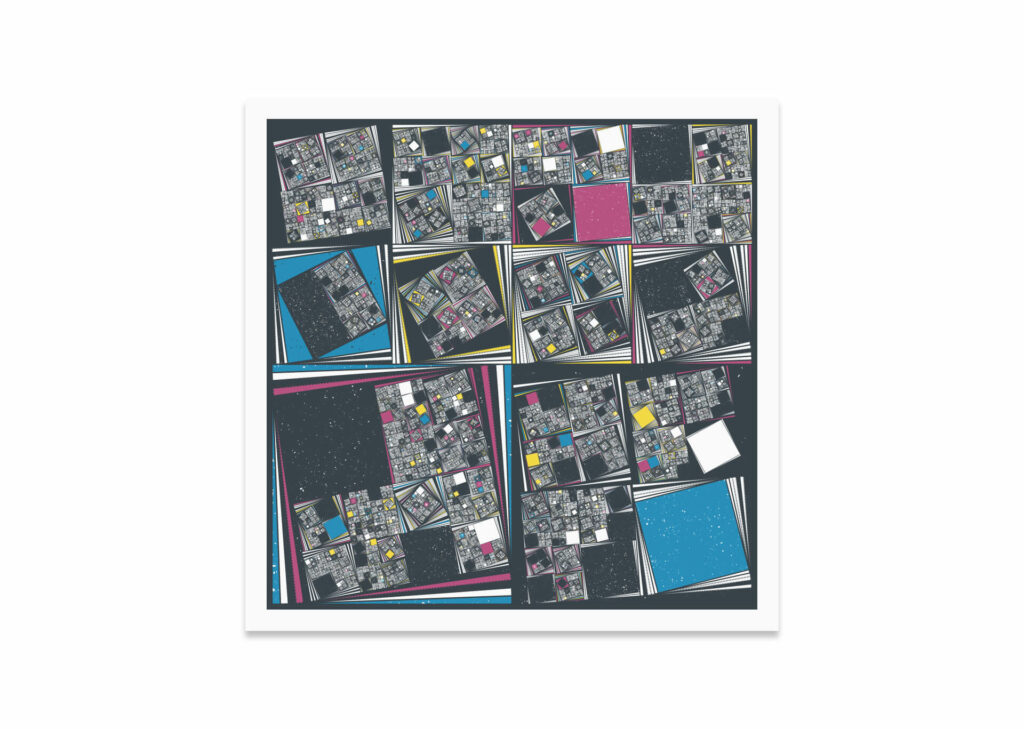In his presentation “A Box of Chaos: The Generative Artist’s Toolkit”, Benjamin Kovach, a programmer by day and a generative artist by night, shared his journey and expertise with generative art through a comprehensive presentation.
Generative art, as Ben explained, is a fusion of randomness and algorithmic precision, where the unpredictability of the former meets the controlled logic of the latter to create digital masterpieces.
First Ben introduced the audience to the basic concepts of generative art, emphasizing the balance between chaos and control necessary to produce visually appealing work. He discussed the elements and principles of art, such as color, form, and texture, and how they are manipulated through principles like balance, rhythm, and emergence to create art that often surprises both the artist and the viewer. He used Kandinsky’s “Composition Eight” to illustrate these principles in action, showing how they guide the viewer’s eye and create movement within a piece.

Moving into the technical aspects, Ben detailed the tools and algorithms that serve as the backbone of generative art. He described the Cartesian plane as the canvas and how points within this space are manipulated using linear algebra to create shapes and lines. Randomness, introduced through pseudo-random number generation, allows for the creation of unique patterns and textures within each piece. Ben highlighted the use of noise functions like Perlin and simplex noise to add naturalistic movement and flow to his artwork, demonstrating this with an animation that used noise to create a dynamic, flowing pattern.
Later Ben delved into specific algorithms that aid in the creation of generative art. He described the Markov chain-based subdivision algorithm used in his piece “Acid City,” which creates a visually appealing pattern through a process of repeated slicing of a quadrilateral. He also touched upon the Chaikin curve subdivision for creating smooth curves and the challenges of color selection, advocating for the HSV color model over RGB for its ease of use.

Texture was another focal point, with Ben sharing his technique for creating a textured black square inspired by Malevich’s work. By stacking circles of varying sizes and positions, he achieved a textured effect that added depth and complexity to the piece. He also discussed the principle of emergence, where simple repeated actions, like connecting midpoints of a square, lead to complex and unexpected patterns, as seen in one of his early works that he later printed and sold.
At the end Ben addressed the curation process, a critical but often overlooked aspect of generative art. He described how he generates hundreds of images and then selects the most compelling ones, a practice that has sharpened his eye for detail and composition over time. He also spoke about the “sweet spot” in controlling randomness, mentioning how he uses static components to anchor his pieces while allowing for variability in textures and other elements.
Ben also answered an audience question about the role of computational methods in art creation, affirming that they are both a means to an end and an interesting aspect of the creative process in their own right. He clarified that he does not use editing software to tweak his images post-generation, preferring to rerun the program with the same seed to make adjustments, thus maintaining the authenticity of the generative process.
Throughout his presentation, Ben’s passion for generative art was palpable. He provided a window into a world where art and algorithm coalesce, offering insights into the creative and technical processes that underpin this unique form of artistic expression. His talk was not just a showcase of his own work but also an invitation to appreciate the intricate dance between order and chaos that defines generative art.
Ben’s presentation was a testament to the evolving nature of art in the digital age, highlighting how traditional principles of art are being reinterpreted through the lens of modern technology. His approachable demeanor and clear explanations made complex concepts accessible, and his work inspired others to explore the unpredictable beauty of generative art. As a curator of his creations, Ben demonstrated the importance of discernment and the joy of discovery in this digital frontier, where every iteration holds the potential for surprise and delight.
Check out Ben’s work on his website and watch the whole presentation here:
